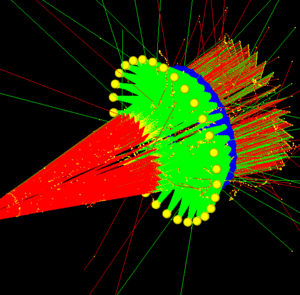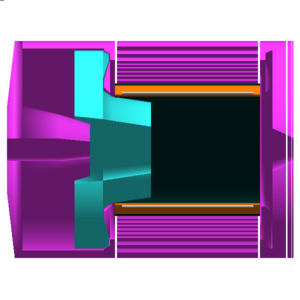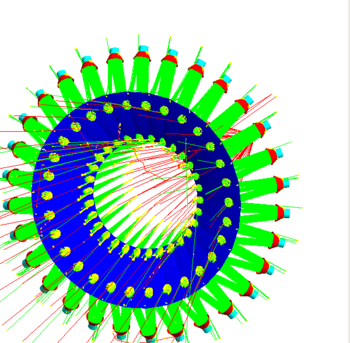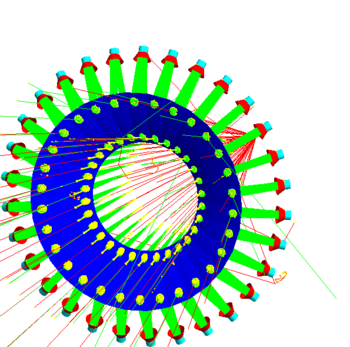Solid Cherenkov SIDIS
This page has been moved to https://solid.jlab.org/wiki/index.php/Cherenkov_SIDIS in the new SoLID Wiki. Please do not edit this page.
Contents
General information
The light gas Cherenkov for SIDIS will be mainly used to separate electrons from pions thus it will be filled with CO2 at 1 atm (index of refraction n = 1.00045) to give a very low momentum threshold for electrons - 0.017 GeV - and a medium momentum threshold for pions - 4.75 GeV. In principle, the light gas Cherenkov can also be used for pion-proton/kaon separation at high momentum considering that only protons and kaons with a momentum of 8 GeV or larger would fire the detector. However, in practice only pions with a momentum > ~7 GeV will give a large enough number of Cherenkov photons for a reliable signal.
Design
Some of the most important design requirements for SIDIS are as follows: the Cherencov focusing system has to accomodate particles with a range of polar angles and a 360 deg coverage in the azimuthal angle; it also has to focus the Cherenkov light coming from particles with a range of momenta that pass through the magnetic field of SoLID; the PMTs have to be positioned in a minimum magnetic field region inside the tank; the PMTs have to face opposite to the target in order to be shielded from possible backgrounds coming from the target; the tank size is limitted by the beam line - floor clearence in Hall A (3.05 m)
Early design ideas: 3-mirror design
The optical system for the SIDIS light gas Cerenkov was originally envisioned (by Yi Qiang) as a three-mirror system that would focus the Cerenkov light to PMTs that are facing oposite to the target. Detailed information on this design can be found here. Each of the 3 mirrors was made of 30 smaller mirrors corresponding to the 30 sectors of SIDIS so one would have a total of 90 mirrors. The first mirror encountered by the Cherenkov light was spherical while the remaining two were cylindrical. The Observer (the focusing point of the 3 mirrors) was simulated as a 10 inch diameter sphere (no real simulation of Winston cones, PMTs). Assuming perfect reflectivity for the 3 mirrors, the collection efficinecy for this system was very good: > 98%. The space limitations in the Hall were not taken into account (tank/mirrors were too large) and the real magnetic field map for SoLID was not implemented (a uniform field of 1.4 T was assumed instead).
Current design: 1-mirror design
The one mirror design was thought of when taking into account the limitation given by the beamline-floor clearence. Once it prooved to be suitable for the SIDIS requirements it became the natural choice due to its simplicity. The picture below shows the one spherical mirror system (blue) focusing the Cherenkov light (green) to the Observers (yellow).
Tank
The tank shape follows right now the design specifications from the GEANT3 simulation (see proposal).
Mirror
The big mirror that covers 360 deg in the azimuthal angle is a system of 30 smaller spherical mirrors.
Winston Cone
Winston cones are used to focus ~ parallel rays onto a smaller area. The modified Winston cones (red in picture below) I am using now have entrance and exit appertures of about 10 inch and 6 inch, respectively. I would use several PMTs (2 inch probably) bunched together to cover the exit apperture of a modified Winston cone.
PMT
update from 7/20/2011: http://hallaweb.jlab.org/12GeV/SoLID/download/cherenkov/CerUpdate.pdf
Detector Response
References
http://www.jlab.org/~simona/transv_12gev/meetings/software_meeting_march2.pdf



